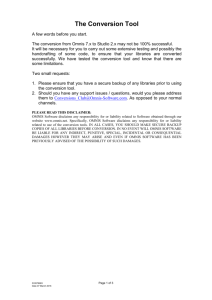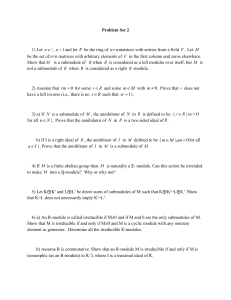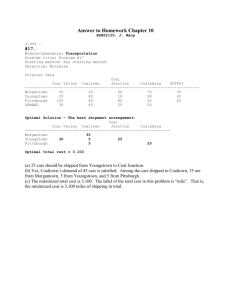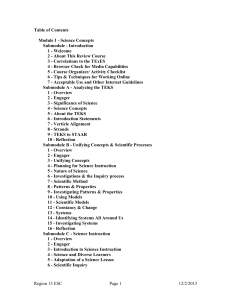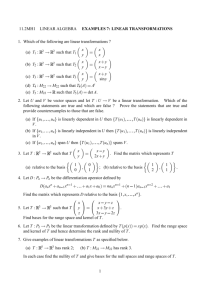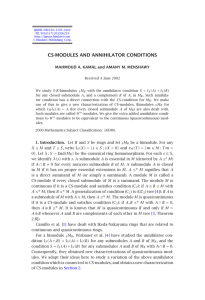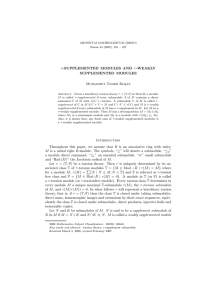Homework Set 1
advertisement
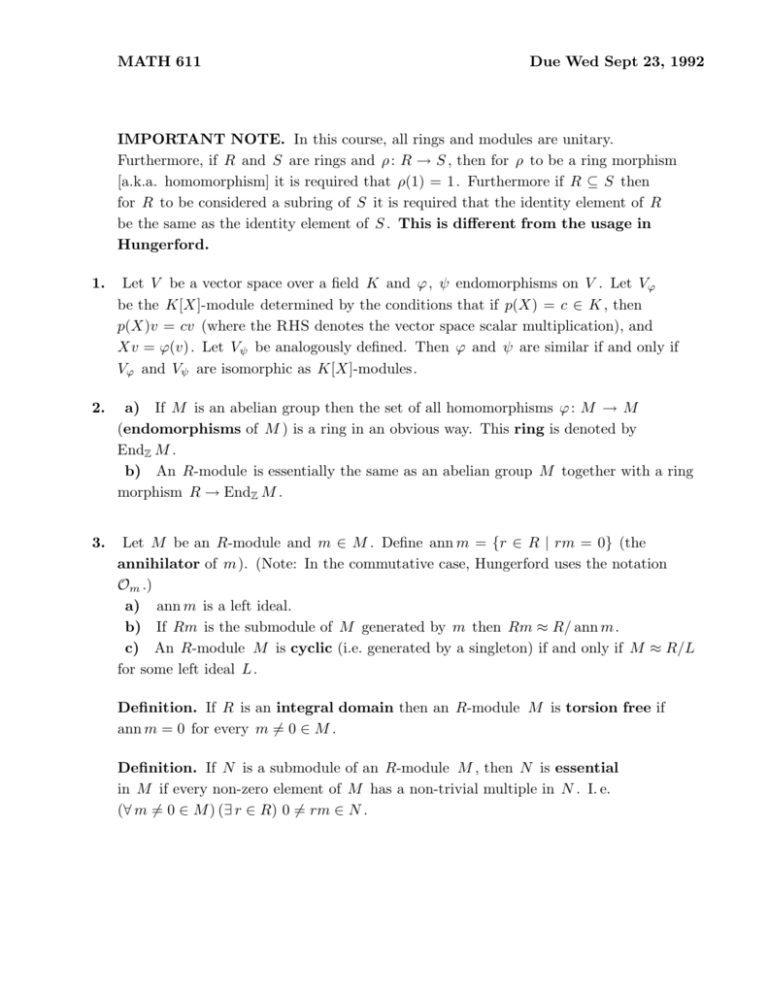
MATH 611
Due Wed Sept 23, 1992
IMPORTANT NOTE. In this course, all rings and modules are unitary.
Furthermore, if R and S are rings and ρ : R → S , then for ρ to be a ring morphism
[a.k.a. homomorphism] it is required that ρ(1) = 1 . Furthermore if R ⊆ S then
for R to be considered a subring of S it is required that the identity element of R
be the same as the identity element of S . This is different from the usage in
Hungerford.
1.
Let V be a vector space over a field K and ϕ, ψ endomorphisms on V . Let Vϕ
be the K[X]-module determined by the conditions that if p(X) = c ∈ K , then
p(X)v = cv (where the RHS denotes the vector space scalar multiplication), and
Xv = ϕ(v) . Let Vψ be analogously defined. Then ϕ and ψ are similar if and only if
Vϕ and Vψ are isomorphic as K[X]-modules.
2.
a) If M is an abelian group then the set of all homomorphisms ϕ : M → M
(endomorphisms of M ) is a ring in an obvious way. This ring is denoted by
EndZ M .
b) An R-module is essentially the same as an abelian group M together with a ring
morphism R → EndZ M .
3.
Let M be an R-module and m ∈ M . Define ann m = {r ∈ R | rm = 0} (the
annihilator of m). (Note: In the commutative case, Hungerford uses the notation
Om .)
a) ann m is a left ideal.
b) If Rm is the submodule of M generated by m then Rm ≈ R/ ann m.
c) An R-module M is cyclic (i.e. generated by a singleton) if and only if M ≈ R/L
for some left ideal L .
Definition. If R is an integral domain then an R-module M is torsion free if
ann m = 0 for every m =
6 0 ∈ M.
Definition. If N is a submodule of an R-module M , then N is essential
in M if every non-zero element of M has a non-trivial multiple in N . I. e.
(∀ m 6= 0 ∈ M ) (∃ r ∈ R) 0 6= rm ∈ N .
4.
a) If M is a torsion free module over an integral domain R and S is a subset of
M , then S is a maximal linearly independent subset of M if and only if S generates
an essential submodule of M .
b) If M is a torsion free module over an integral domain M and there exists a
finite subset S of M consisting of n elements which generates an essential submodule
of M , then any subset of M containing more than n elements is linearly dependent.
(Compare Hungerford, Theorem 2.7, p. 185.)
Definition. If M is an R-module then we define the rank of M in the following two
cases:
(1) If R is commutative or more generally R has the invariant dimension property
and if M is a free R-module, then rank M is the cardinality of a basis for M .
(2) If R is an integral domain and M is a torsion free R-module, then rank M is
the cardinality of any maximal linearly independent subset of M .
There are certain other cases where it makes sense to define rank M . However it is not
possible to extend the concept of rank in complete generality to all modules over an
arbitrary rang. Furthermore, the term “rank” is sometimes used both in group theory
and module theory with other meanings than the one above.
In order for the second definition to make sense, we need to know that all maximal
linearly independent subsets of M have the same cardinality. This is in fact true.
If R is an integral domain and M is a free R-module, then R is torsion free and so
both definition (1) and (2) apply. It is not obvious that they agree in this case, but
they do.
5.
If M is a torsion free module over an integral domain M then rank M as given by (2)
in the above definition is well defined.
September 23 Answers
1.
note: In this course, as in most of contemporary algebra, in order for a map
ϕ : A → B to be called an isomorphism it must be both a monomorphism (one-to-one)
and a surjection (“onto”).
One first needs to prove that if Vϕ is a K[X]-module and θ : Vϕ → Vϕ , then θ is a
homomorphism of K[X]-modules if and only if θ is a K-linear transformation and
θ(Xv) = Xθ(v) . In fact, “( ⇒ ): ” is obvious. On the other hand, if θ is K-linear and
θ(Xv) = Xθ(V ) and p(X) is an arbitary element in K[X] (i.e. a polynomial) then
θ(p(X)v) = p(X)θ(v) because blah blah blah.
Now if θ : Vϕ → Vψ then the condition θ(Xv) = Xθ(v) translates to θϕ(v) = ψθ(v) .
This is true for all v ∈ V if and only if θϕ = ψθ . If, in addition θ −1 exists then we
can multiply this equation on the left by θ −1 to see that it is equivalent to ϕ = θ −1 ψθ .
Summarizing: There exists an invertible linear transformation θ (i.e. an isomorphism)
from V into itself such that ϕ = θ −1 ψθ if and only if there exists θ : Vϕ → Vψ which is
K[X]-linear and an isomorphism.
But this says that ϕ is similar to ψ if and only if Vϕ and Vψ are isomorphic as
K[X]-modules.
2.
a) In order to prove that EndZ M is a ring, there are all sorts of annoying little
details to verify, most of which are pretty much obvious. The most important thing is
to be aware of what these points are. The most important thing to note is that, by
definition, if ϕ, ψ ∈ EndZ M then
ϕ = ψ ⇐⇒ (∀m ∈ M ) ϕ(m) = ψ(m).
Now for ϕ, ψ ∈ EndZ M , ϕ + ψ and ϕψ are defined by setting
(ϕ + ψ)(m) = ϕ(m) + ψ(m)
and
(ϕψ)(m) = ψ(ϕ(m)).
The items that need to be checked are: (1) ϕ + ψ and ϕψ are in fact homomorphisms.
(2) The above addition is commutative and associative, i.e. ϕ + ψ = ψ + ϕ and if also
χ ∈ EndZ M then χ(ϕψ) = (χϕ)ψ . (Refer to the above note for the meaning of these
equalities.) (3) Multiplication is associative (although probably not commutative). (4)
The two distributive laws hold. (5) There exists a map commonly called the zero map
which acts as the zero element in the ring EndZ M . (6) There exists a map commonly
called the identity map which acts as the multiplicative identity in this ring. I.e. if we
denote the identity map by 1M , then for all ϕ ∈ EndZ M , 1M ϕ = ϕ1m = ϕ.
b) Now if a homomorphism ρ : R → EndZ M is given then we can define a
multiplication between R and M by setting rm equal to (ρ(r))(m) . (Please become
comfortable with this kind of notation. What it means is that if ρ(r) = ϕ ∈ EndZ M
then rm is defined to be ϕ(m) , which makes sense because m ∈ M and ϕ : M → M .)
One needs to check all the axioms to see that this does in fact make M into
R-module. (This is tedious, but you can be fairly sketchy.)
On the other hand, if we start with a multiplication between R and M then we can
define ρ ∈ EndZ M as follows: if r ∈ R then ρ(r) : M → M is defined by setting
(ρ(r))(m) = rm. One needs to check to see that for each r ∈ R , ρ(r) is in fact an
endomorphism of the abelian group M , i.e. that ρ(r)(m1 + m2 ) = ρ(r)(m1 ) + ρ(r)(m2 ) .
Furthermore, one needs to see that ρ is a homomorphism of rings between R and
EndZ M , i.e. that ρ(r1 + r2 ) = ρ(r1 ) + ρ(r2 ) and that ρ(r1 r2 ) = ρ(r1 )ρ(r2 ) . This last
equation means that for all m ∈ M , ρ(r1 r2 )(m) = ρ(r1 )[ ρ(r2 )(m)] .
3.
a) The proof that ann m is a left ideal is completely routine. Note that if R is not
commutative then ann m is usually not a right ideal.
b) Start by defining a map ϕ : R → Rm by simply setting ϕ(r) = rm. By the very
definition of the cyclic module Rm this is surjective. Note also that the definition
of ann m can be rephrased as stating that r ∈ ann m if and only if ϕ(r) = 0 . Thus
Ker ϕ = ann m. For convenience, write L = ann m. Now, as is done in Hungerford,
Theorem 1.7, p.172, one can define a map ϕ̄ : R/L → Rm by setting ϕ̄(r + L) = ϕ(r) .
If you don’t use Theorem 1.7 you need to check that this is well defined , i.e. that if
r + L = r0 + L then ϕ(r) = ϕ(r 0 ) . You also need to check that if it a monomorphism,
i.e. that ϕ̄(r + L) = 0 if and only if r + L = 0 + L . And finally you need to know that
ϕ̄ is an R-linear map. (Theorem 1.7 really saves a lot of work.) Since ϕ̄ is surjective
because ϕ is, it follows that ϕ̄ is an isomorphism from R/ ann m onto Rm.
b) This is almost just a rewording of part b). We’ve already shown that every cyclic
module is isomorphic to R/L for some left ideal L . ( L is usually not unique, although
it is if R is commutative. (This is not obvious, but not extremely hard.) ) It remains
to see that if a module is isomorphic to R/L for some left ideal L then it must be
cyclic. It suffices to show that R/L is always cyclic for every L . But in fact one easily
shows that R/L is generated as an R-module by the coset 1 + L .
4.
Oops! What part a) of this problem should have said is that if S is a linearly
independent subset of M then S is a maximal linearly independent set if and only if
it generates an essential submodule of M .
In fact, under the assumption that S is linearly independent it is easy to see that S
is a maximal linearly independent set of M if and only if for each m ∈
/ S there is an
equation of the form
X
rm =
ri s i
with the si distinct elements of S , and r, ri ∈ R with almost all ri = 0 but r 6= 0 .
But this is exactly equivalent to saying that if 0 6= m ∈ M then some non-zero multiple
of m is in the submodule generated by S . (We need only worry about those m with
m∈
/ S . Note that r 6= 0 and m 6= 0 implies rm 6= 0 since by assumption M is torsion
free.) And that’s the same as saying that the submodule generated by S is an essential
submodule of M .
a) This is a complete steal from the proof of Theorem 2.7, p. 185. If S contains n
elements and generates an essential submodule of M and T contains more than n
elements, then one by one replaces elements of S by elements of T , at each step
retaining the property that the submodule generated by the new set is an essential
submodule of M . The only alteration is that since one can’t divide we’re not able to
conclude that this submodule is actually all of M . Finally, one arrives at a subset T 0
of T containing n elements which generates an essential submodule of M . Then T 0
cannot be all of T (why?) so there exists t ∈ T with t ∈
/ T 0 . Then since T 0 generates
an essential submodule of M , some non-zero multiple of t belongs to the submodule
Pn
P
generated by T 0 , i.e. rt = 1 ri ti with ti ∈ T 0 and r 6= 0 . Then −rt + ri ti = 0 is a
non-trivial relation among elements of T , so T is linearly dependent.
5.
Well, this is partly another “oops!” I should have told you to only deal with the case
of finite rank, since you don’t know the set theory (or the algebra!) for the infinite
rank case.
Okay, so assume that M contains a maximal linearly independent set S with n
elements. Then if S 0 is any other maximal linearly independent set, S 0 cannot have
more than n elements, otherwise by problem 4 it couldn’t be linearly independent.
(Note that this excludes the possibility that S 0 is infinite.) On the other hand, if S 0
had less than n elements then by problem 4 S couldn’t be linearly independent,
another contradiction. Thus we see that all maximal linearly independent subsets of M
must have exactly n elements.
